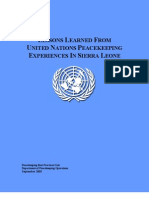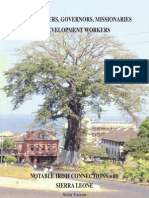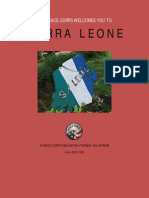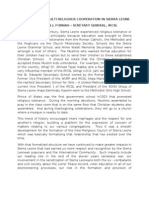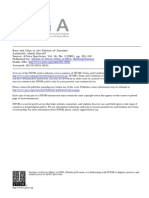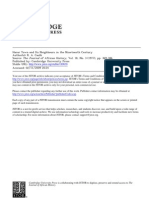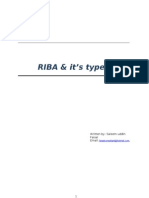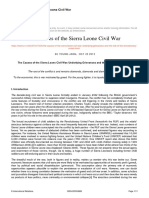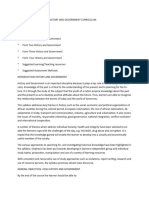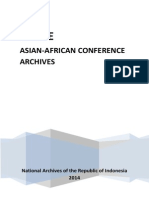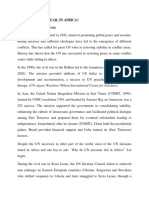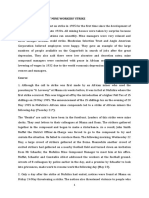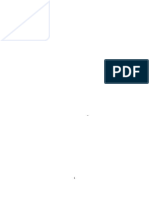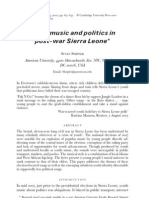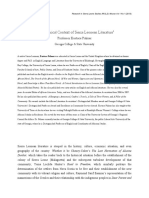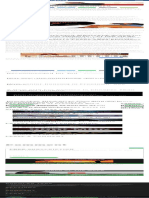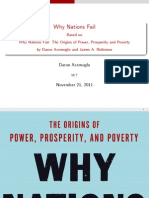Sierra Leone
Sierra Leone
Uploaded by
mudit1gulatiCopyright:
Available Formats
Sierra Leone
Sierra Leone
Uploaded by
mudit1gulatiCopyright
Available Formats
Share this document
Did you find this document useful?
Is this content inappropriate?
Copyright:
Available Formats
Sierra Leone
Sierra Leone
Uploaded by
mudit1gulatiCopyright:
Available Formats
Sierra Leone ( i/sr lon/ or /lon/),[3] officially the Republic of Sierra Leone, is a country in West Africa that is bordered
by Guinea to the northeast, Liberia to the southeast, and the Atlantic Ocean to the southwest. Sierra Leone has a tropical climate, with a diverse environment ranging from savannah to rainforests. The country covers a total area of 71,740 km2 (27,699 sq mi)[4] and is divided into four geographical regions: the Northern Province, Eastern Province, Southern Province and the Western Area; which are subdivided into fourteen districts. The districts have their own directly elected local government known as district council, headed by a council chairman. Freetown, located in the Western Area of the country, is the capital, largest city as well as its economic, commercial and political centre. Bo, located in the Southern Province of the country, is the country's second largest city and the second major economic and commercial centre. The country is a constitutional republic and with an estimated population of 6 million (2011 United Nations estimate).[5][6] Sierra Leone has relied on mining, especially diamonds, for its economic base. The country is among the largest producers of titanium and bauxite, and a major producer of gold. The country has one of the world's largest deposits of rutile. Sierra Leone is also home to the third largest natural harbour in the world, where shipping from all over the globe berth at Freetown's famous Queen Elizabeth II Quay. Despite this natural wealth, 70% of its people live in poverty.[7] Sierra Leone is a predominantly Muslim country,[8][9][10] though with an influential Christian minority. Sierra Leone is ranked as one of the most religiously tolerant nations in the world.[11][12][13] People are often married across ethnic and religious boundaries. Muslims and Christians collaborate and interact with each other peacefully [1].[11] Religious violence is very rare in the country. The population of Sierra Leone comprises about sixteen ethnic groups, each with its own language and costume. The two largest and most influential are the Temne and the Mende. Although English is the language of instruction in schools and the official language in government administration, the Krio language (derived from English and several indigenous African languages) is the primary language of communication among Sierra Leone's different ethnic groups, and is spoken by 90% of the country's population.[1] The Krio Language unites all the different ethnic groups, especially in their trade and interaction with each other.[14] In 1462, the area that is now Sierra Leone was visited by the Portuguese explorer Pedro de Sintra, who named it Serra Leoa, meaning "Lioness Mountains".[15][16] Sierra Leone later became an important centre of the transatlantic trade in slaves until 11 March 1792 when Freetown was founded by the Sierra Leone Company as a home for former enslaved from (or freed by) the British Empire.[17] In 1808, Freetown became a British Crown Colony, and in 1896, the interior of the country became a British Protectorate.[18] Between 1991 and 2002 the Sierra Leone Civil War devastated the country leaving more than 50,000 people dead, much of the country's infrastructure destroyed, and over two million people displaced in neighbouring countries as refugees; mainly to Guinea, which was home to over 600,000 Sierra Leonean refugees.
Contents
1 History o 1.1 Early history o 1.2 Early colonies o 1.3 Colonial era o 1.4 1960 Independence Conference o 1.5 Opposition of the SLPP government o 1.6 An Independent nation and Sir Milton Margai Administration o 1.7 Sir Albert Administration o 1.8 Three military coups, 19671968 o 1.9 Stevens' government and one-party state o 1.10 Momoh Administration o 1.11 Multi-party constitution and Revolutionary United Front rebellion (1991 to 2001) o 1.12 NPRC Junta o 1.13 Return to civilian rule o 1.14 AFRC junta o 1.15 Kabbah's government and the end of civil war 2 Geography and climate o 2.1 Environment 3 Government and politics o 3.1 Foreign relations 4 Provinces and districts 5 Economy 6 Demographics o 6.1 Religion o 6.2 Ethnic groups 7 Education 8 Health 9 Military 10 Law enforcement 11 Transportation 12 Drinking water supply 13 Food and customs 14 Culture o 14.1 Arts o 14.2 Sports o 14.3 Media 15 See also 16 Notes 17 Book references o 17.1 Primary sources o 17.2 Secondary sources 18 External links
History
Main article: History of Sierra Leone
Early history
Fragments of prehistoric pottery from Kamabai Rock Shelter
An 1835 illustration of liberated Africans arriving in Sierra Leone.
The colony of Freetown in 1856 Archaeological finds show that Sierra Leone has been inhabited continuously for at least 2,500 years,[19] populated by successive movements from other parts of Africa.[20] The use of iron was introduced to Sierra Leone by the 9th century, and by 1000 A.D. agriculture was being practiced by coastal tribes.[21] Sierra Leone's dense tropical rainforest largely protected it from the influence of any pre-colonial African empires[22] and from further Islamic influence of the Mali Empire. The Islamic faith, however, became common in the 18th century.[23] European contacts within Sierra Leone were among the first in West Africa. In 1462, Portuguese explorer Pedro de Sintra mapped the hills surrounding what is now Freetown Harbour, naming shaped formation Serra de Leo (Portuguese for Lion Mountains).[16] The Italian rendering of this geographic formation is Sierra Leone, which became the country's name. Soon after Portuguese traders arrived at the harbour and by 1495 a fort that acted as a trading post had been built.[24] The Portuguese were joined by the Dutch and French, all of them
using Sierra Leone as a trading point for slaves.[25] In 1562, the English joined the human trade when Sir John Hawkins shipped 300 enslaved peopleacquired "by the sword and partly by other means"to the new colonies in America.[26]
Early colonies
In 1787 a settlement was founded in Sierra Leone in what was called the "Province of Freedom". A number of "Black Poor" arrived off the coast of Sierra Leone on 15 May 1787, accompanied by some English tradesmen. Many of the "black poor" were African Americans, who had been given their freedom after seeking refuge with the British Army during the American Revolution, but also included other West Indian, African and Asian inhabitants of London. After establishing Granville Town, disease and hostility from the indigenous people eliminated the first group of colonists and destroyed their settlement. A second Granville Town was established by 64 remaining colonists.[27] Through the impetus of Thomas Peters, the Sierra Leone Company was established to relocate Black Loyalists, who had escaped enslavement in the United States by seeking protection with the British Army during the American Revolution. They had been given land in Nova Scotia and founded Birchtown, Nova Scotia but faced harsh winters and racism. Led by Thomas Peters and British abolitionist John Clarkson, 1196 of the Black Loyalists from Nova Scotia crossed the Atlantic to built the second (and only permanent) Colony of Sierra Leone and the settlement of Freetown on 11 March 1792. In Sierra Leone they were called the Nova Scotian Settlers, the Nova Scotians, or the Settlers. The Settlers built Freetown and introduced North American architectural styles from the American South as well as Western fashion and American manners. In the 1790s, the Settlers voted for the first time in elections, as did women.[28] The Sierra Leone Company refused to allow the settlers to take freehold of the land. Some of the Settlers revolted in 1799. The revolt was only put down by the arrival of over 500 Jamaican Maroons, who also arrived via Nova Scotia. In 1800, Jamaican Maroons from Trelawny Town, Jamaica were settled via Nova Scotia. After sixteen years of running the Colony, the Sierra Leone Company was formed into the African Institution. The Institution met in 1807 to achieve more success by focusing on bettering the local economy, but it was constantly split between those British who meant to inspire local entrepreneurs and those with interest in the Macauley & Babington Company which held the (British) monopoly on Sierra Leone trade.[29] Beginning in 1808 (following the abolition of the slave trade in 1807), thousands of formerly enslaved Africans were liberated in Freetown. Most of these Liberated Africans or 'Recaptives' chose to remain in Sierra Leone. Cut off from their homes and traditions, the Liberated Africans assimilated the Western styles of Settlers and Maroons and built a flourishing trade of flowers and beads on the West African coast. These returned Africans were from many areas of Africa, but principally the west coast. During the 19th century many black Americans, Americo Liberian 'refugees', and particularly West Indians immigrated and settled in Freetown creating a new ethnicity called the Krio.
Colonial era
Bai Bureh, leader of the 1898 rebellion against British rule
Photograph of British West African Campaign troops in Freetown, c. 19141916. Published caption: "BRITISH EXPEDITIONARY FORCE PREPARING TO EMBARK AT FREETOWN TO ATTACK THE GERMAN CAMEROONS, THE MAIN OBJECT OF THE ATTACK BEING THE PORT OF DUALA. AUXILIARY NATIVE TROOPS WERE FREELY USED IN AFRICAN WARFARE." In the early 20th century, Freetown served as the residence of the British governor who also ruled the Gold Coast (now Ghana) and the Gambia settlements. Sierra Leone also served as the educational centre of British West Africa. Fourah Bay College, established in 1827, rapidly became a magnet for English-speaking Africans on the West Coast. For more than a century, it was the only European-style university in western Sub-Saharan Africa. During Sierra Leone's colonial history, indigenous people mounted several unsuccessful revolts against British rule. The most notable was the Hut Tax war of 1898. The Hut Tax War consisted of a Northern front, led by Bai Bureh, and Southern front that were sparked at different times and for different reasons. Bureh's fighters had the advantage over the vastly more powerful British for several months of the war. Hundreds of British troops and hundreds of Bureh's fighters were killed.[30] Bai Bureh was finally captured on 11 November 1898 and sent into exile in the Gold Coast (now Ghana), while 96 of his comrades were hanged by the British. The defeat in the Hut Tax war ended large-scale organised resistance to colonialism; however resistance continued throughout the colonial period in the form of intermittent rioting and
chaotic labour disturbances. Riots in 1955 and 1956 involved "many tens of thousands" of natives in the protectorate.[31] One notable event in 1935 was the granting of a monopoly on mineral mining to the Sierra Leone Selection Trust run by De Beers, which was scheduled to last 98 years. In 1924, Sierra Leone was divided into a Colony and a Protectorate, with separate and different political systems constitutionally defined for each. Antagonism between the two entities escalated to a heated debate in 1947, when proposals were introduced to provide for a single political system for both the Colony and the Protectorate. Most of the proposals came from the Protectorate. The Krio, led by Isaac Wallace-Johnson, opposed the proposals, the main effect of which would have been to diminish their political power. It was due to the astute politics of Sir Milton Margai that the educated Protectorate elite was won over to join forces with the paramount chiefs in the face of Krio intransigence. Later, Sir Milton used the same skills to win over opposition leaders and moderate Krio elements for the achievement of independence. In November 1951, Sir Milton Margai oversaw the drafting of a new constitution, which united the separate Colonial and Protectorate legislatures andmost importantlyprovided a framework for decolonization.[32] In 1953, Sierra Leone was granted local ministerial powers, and Sir Milton Margai, was elected Chief Minister of Sierra Leone.[32] The new constitution ensured Sierra Leone a parliamentary system within the Commonwealth of Nations.[32] In May 1957, Sierra Leone held its first parliamentary election. The SLPP, which was then the most popular political party in the colony of Sierra Leone, won the most seats in Parliament. Margai was also re-elected as Chief Minister by a landslide.
1960 Independence Conference
On 20 April 1960, Sir Milton Margai led the twenty four members of the Sierra Leonean delegation at the constitutional conferences that were held with Queen Elizabeth II and British Colonial Secretary Iain Macleod in the negotiations for independence held at the Lancaster House in London.[33][34] All of the twenty four members of the Sierra Leonean delegation were prominent and well-respected politicians including Sir Milton himself, his younger brother lawyer Sir Albert Margai, the outspoken trade unionist Siaka Stevens, SLPP strongman Lamina Sankoh, outspoken Creole activist Isaac Wallace-Johnson, Dr John Karefa-Smart, Paramount chief Ella Koblo Gulama, educationist Mohamed Sanusi Mustapha, professor Kande Bureh, lawyer Sir Banja Tejan-Sie, former Freetown's Mayor Eustace Henry Taylor Cummings educationist Amadu Wurie, and Creole diplomat Hector Reginald Sylvanus Boltman.[35] On the conclusion of talks in London, Britain agreed to grant Sierra Leone Independence on 27 April 1961. However, the outspoken trade unionist Siaka Stevens was the only delegate who refused to sign Sierra Leone's declaration of Independendence on the grounds that there had been a secret defence pact between Sierra Leone and Britain; another point of contention by Stevens was the Sierra Leonean government's position that there would be no elections held before independence which would effectively shut him out of Sierra Leone's political process.[36] Upon their return to Freetown on 4 May 1960, Stevens was promptly expelled from the People's National Party (PNP).
Opposition of the SLPP government
On 24 September 1960, outspoken critic of the SLPP government, Siaka Stevens, formed an alliance with several prominent northern politicians including Sorie Ibrahim Koroma, Christian Alusine-Kamara Taylor, Mohammed Bash-Taqui, S.A.T. Koroma, Kawusu Konteh, Allieu Badarr Koroma, S.A. Fofana and Mucktarru Kallay to form their own political party called the All People's Congress (APC) in opposition of the SLPP government. Stevens took advantage of the dissatisfaction with the ruling SLPP among some prominent politicians from the Northern part of Sierra Leone to form the APC; and Stevens used the Northern part of Sierra Leone as his political base.
You might also like
- Conflict & Collusion in Sierra Leone - KeenDocument177 pagesConflict & Collusion in Sierra Leone - KeenEdward BelseyNo ratings yet
- Ancestors ImamDocument34 pagesAncestors ImamSaleem Miankhel LohaniNo ratings yet
- UN - 2003 - Lessons Learned From Sierra LeoneDocument86 pagesUN - 2003 - Lessons Learned From Sierra Leoneapi-19962300100% (1)
- African EntrepreneurshipDocument320 pagesAfrican EntrepreneurshiperiwirandanaNo ratings yet
- Irish Connections Sierra-LeoneDocument16 pagesIrish Connections Sierra-LeoneDeclan Max Brohan100% (1)
- Sierra Leone Case StudyDocument39 pagesSierra Leone Case StudyDaniel KounahNo ratings yet
- Peace Corps Sierra Leone Welcome Book - June 2013Document61 pagesPeace Corps Sierra Leone Welcome Book - June 2013Accessible Journal Media: Peace Corps DocumentsNo ratings yet
- Sierra Leone Civil Society and The 2007 ElectionsDocument20 pagesSierra Leone Civil Society and The 2007 ElectionswacsiNo ratings yet
- The Frontier in Sierra Leone Past Experi PDFDocument29 pagesThe Frontier in Sierra Leone Past Experi PDFNile DaviesNo ratings yet
- Sierra Leone Mudslide Case StudyDocument8 pagesSierra Leone Mudslide Case StudyR HarpNo ratings yet
- Sierra LeoneDocument11 pagesSierra LeoneTanyaNNo ratings yet
- Sierra Leone Case Study - FornahDocument4 pagesSierra Leone Case Study - FornahReligions for Peace - InternationalNo ratings yet
- Breaking The Barriers: Sierra Leonean Women On The MarchDocument13 pagesBreaking The Barriers: Sierra Leonean Women On The MarchOxfamNo ratings yet
- UNICEF Sierra Leone Newsletter Sep 2013Document8 pagesUNICEF Sierra Leone Newsletter Sep 2013Rosmarie JahNo ratings yet
- Sierra Leone Budget Speech 2015Document23 pagesSierra Leone Budget Speech 2015tapia4yeabuNo ratings yet
- Sierra Leone: The Universities Act of 2005Document26 pagesSierra Leone: The Universities Act of 2005Felis_Demulcta_MitisNo ratings yet
- Sierra Leone Planning MapDocument1 pageSierra Leone Planning MapMirsadNo ratings yet
- Policy Advocacy and Engagement Training Narrative Report - Freetown, Sierra Leone (December 12 - 15, 2011)Document27 pagesPolicy Advocacy and Engagement Training Narrative Report - Freetown, Sierra Leone (December 12 - 15, 2011)wacsiNo ratings yet
- Child Soldiers in Sierra Leone and The Problems of DemobilizationDocument10 pagesChild Soldiers in Sierra Leone and The Problems of DemobilizationarisplaNo ratings yet
- Sierra Leone: Submitted By: Jenny D. Pabualan BSA - 1 Jane F. Vidad BSA - 1Document16 pagesSierra Leone: Submitted By: Jenny D. Pabualan BSA - 1 Jane F. Vidad BSA - 1Jenny PabualanNo ratings yet
- Cases LawDocument13 pagesCases LawPuteri Intan100% (1)
- Henry VII Student NotesDocument26 pagesHenry VII Student Notesapi-286559228No ratings yet
- Sessay TrialDocument834 pagesSessay TrialCarlo MercadoNo ratings yet
- Maternal Mortality in Sierra LeoneDocument15 pagesMaternal Mortality in Sierra LeoneChelsea RuthrauffNo ratings yet
- South Africa The Rainbow Nation: A Story of Hope One Nation's Journey To FreedomDocument29 pagesSouth Africa The Rainbow Nation: A Story of Hope One Nation's Journey To FreedomLaura Jessica Victoria KrawczykNo ratings yet
- Parliament UKDocument5 pagesParliament UKredflowerNo ratings yet
- Revit Training Doc. PVVDocument3 pagesRevit Training Doc. PVVpraveencivilvarma9397No ratings yet
- Modernism and Its Double - CatálogoÁfricadoSulBienalde ArquiteturadeVeneza - 2014Document22 pagesModernism and Its Double - CatálogoÁfricadoSulBienalde ArquiteturadeVeneza - 2014Icaro Ferraz Vidal JuniorNo ratings yet
- Port Louis Smart CityDocument16 pagesPort Louis Smart CityL'express Maurice50% (2)
- Race and Class in The Politics of ZanzibarDocument19 pagesRace and Class in The Politics of ZanzibarMZALENDO.NET100% (2)
- 180638Document19 pages180638WadaayNo ratings yet
- RIBA and It's TypesDocument10 pagesRIBA and It's Typesfaisalconsultant100% (2)
- Cyprus A Federal or Two State SolutionDocument31 pagesCyprus A Federal or Two State SolutionFilia pomoniNo ratings yet
- Studies of Religion - Religion in Australia From 1945Document2 pagesStudies of Religion - Religion in Australia From 1945Lachlan BrownNo ratings yet
- General Principles Governing Law of Negligence Part 1Document21 pagesGeneral Principles Governing Law of Negligence Part 1Xian LitNo ratings yet
- Retail Market in Sierra LeoneDocument11 pagesRetail Market in Sierra Leonestack14100% (3)
- Chap 23Document28 pagesChap 23api-240662953No ratings yet
- Industrial Revolution in EnglandDocument4 pagesIndustrial Revolution in EnglandLoreinNo ratings yet
- Sovereignty LTD - Sir George Goldie and The Rise of The Royal Niger CompanyDocument65 pagesSovereignty LTD - Sir George Goldie and The Rise of The Royal Niger CompanyTae From Da ANo ratings yet
- Major Geopolitical Explanations of Conflict in The Horn of AfricaDocument8 pagesMajor Geopolitical Explanations of Conflict in The Horn of AfricaMárcia LopesNo ratings yet
- Countries of Africa: Some Facts About AfricaDocument4 pagesCountries of Africa: Some Facts About AfricanabilahNo ratings yet
- The Causes of The Sierra Leone Civil WarDocument11 pagesThe Causes of The Sierra Leone Civil WarObiaraNo ratings yet
- Somalia HCDocument7 pagesSomalia HCManelle SingzonNo ratings yet
- History Syllabus 1Document60 pagesHistory Syllabus 1MkufunziNo ratings yet
- The Middle East ColdWarDocument9 pagesThe Middle East ColdWarLooking Glass PublicationsNo ratings yet
- Guide Arsip Tematis KAA (English) PDFDocument90 pagesGuide Arsip Tematis KAA (English) PDFHedda Whirlwinds SparkyuNo ratings yet
- The Imperial ChurchesDocument28 pagesThe Imperial ChurchesMiguelo GarciaNo ratings yet
- IerDocument367 pagesIerAlina PlescanNo ratings yet
- RibaDocument26 pagesRibafarhanadvaniNo ratings yet
- Class Notes On The Baganda of Central UgandaDocument3 pagesClass Notes On The Baganda of Central UgandaSheila libuka100% (1)
- Sierra Leone's Maternal Health and Health Human Resource Situation, Glenn BenabloDocument12 pagesSierra Leone's Maternal Health and Health Human Resource Situation, Glenn BenabloGlenn Bede A.BenabloNo ratings yet
- Unleashing RivalryDocument89 pagesUnleashing RivalrySasha OhlmsNo ratings yet
- The Influence of Islam On West Africa Lisa LindsayDocument7 pagesThe Influence of Islam On West Africa Lisa LindsayValeria CrudoNo ratings yet
- Dastuurkii Jamhuuriyadda Soomaaliya 1960Document34 pagesDastuurkii Jamhuuriyadda Soomaaliya 1960ZakariaNo ratings yet
- Why Un Mission Fail in Africa-Manyok Chol DavidDocument5 pagesWhy Un Mission Fail in Africa-Manyok Chol DavidDavid BashirNo ratings yet
- The 1935 Copperbelt Mine WorkersDocument4 pagesThe 1935 Copperbelt Mine Workersmuna moonoNo ratings yet
- Sierra Leone: LocationDocument12 pagesSierra Leone: LocationanaNo ratings yet
- Chapter OneDocument11 pagesChapter OneIsaac kibaleNo ratings yet
- History Assignment 2Document5 pagesHistory Assignment 2Bangalie Mohamed MansarayNo ratings yet
- LiberiaDocument22 pagesLiberiaMihai Iulian PăunescuNo ratings yet
- Youth Music and Politics in Post-War Sierra LeoneDocument16 pagesYouth Music and Politics in Post-War Sierra LeoneSusan SheplerNo ratings yet
- Africa Research Bulletin December 2012Document35 pagesAfrica Research Bulletin December 2012Ben GillNo ratings yet
- 4 156 1 PBDocument31 pages4 156 1 PBAweis SabrieNo ratings yet
- SMWK Press Statement JuneDocument20 pagesSMWK Press Statement Junekemoh1982No ratings yet
- Monday, March 31, 2014 EditionDocument18 pagesMonday, March 31, 2014 EditionFrontPageAfricaNo ratings yet
- APC MPs Endorse Samura Kamara PDFDocument1 pageAPC MPs Endorse Samura Kamara PDFEzekiel KoromaNo ratings yet
- Why Nations Fail Short PresentationDocument49 pagesWhy Nations Fail Short PresentationMaria Valyashova100% (3)
- African Political Parties Evolution Institutionalisation and GovernanceDocument383 pagesAfrican Political Parties Evolution Institutionalisation and GovernanceEsther PG100% (1)


